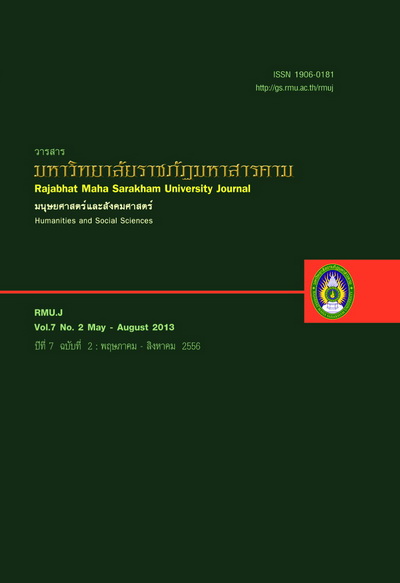สร้างแบบวัดทักษะกระบวนการทางวิทยาศาสตร์ วิชาโลก ดาราศาสตร์และอวกาศ สำหรับนักเรียนชั้นมัธยมศึกษาปีที่ 4 สังกัดสำนักงานเขตพื้นที่การศึกษามัธยมศึกษา เขต 27
Main Article Content
Abstract
บทคัดย่อ
การวิจัยครั้งนี้มีวัตถุประสงค์เพื่อ 1) เพื่อสร้างแบบวัดทักษะกระบวนการทางวิทยาศาสตร์ วิชาโลก ดาราศาสตร์และอวกาศ 2) เพื่อตรวจสอบคุณภาพของแบบวัดทักษะกระบวนการทางวิทยาศาสตร์ และ 3) เพื่อสร้างเกณฑ์ปกติ (Norm) ของแบบวัดทักษะ กระบวนการทางวิทยาศาสตร์ วิชาโลก ดาราศาสตร์และอวกาศ ชั้นมัธยมศึกษาปีที่ 4 กลุ่มตัวอย่างเป็นนักเรียนชั้นมัธยมศึกษาปี ที่ 4 จำนวน 375 คน ศึกษาในภาคเรียนที่ 1 ปีการศึกษา 2554 สังกัดสำนักงานเขตพื้นที่การศึกษามัธยมศึกษา เขต 27 ที่ได้จาก ประชากรทั้งหมด 800 คน โดยวิธีการสุ่มแบบหลายขั้นตอน เครื่องมือที่ใช้ในการวิจัยครั้งนี้ คือ แบบวัดทักษะกระบวนการทาง วิทยาศาสตร์วิชาโลก ดาราศาสตร์และอวกาศ แบบเลือกตอบชนิด 4 ตัวเลือก จำนวน 65 ข้อ หาคุณภาพของแบบวัดโดยหาค่า ความยาก ค่าอำนาจจำแนก ค่าความเชื่อมั่น วิเคราะห์ความเที่ยงตรงเชิงโครงสร้างโดยวิเคราะห์องค์ประกอบเชิงยืนยัน (Confirmatory factor analysis : CFA) และการสร้างเกณฑ์ปกติเพื่อแปลความหมายคะแนนโดยใช้วิธีการเทียบหาตำแหน่งเปอร์เซ็นไทล์ ผลการวิจัยพบว่า
1. ผลการสร้างแบบวัดทักษะกระบวนการทางวิทยาศาสตร์ วิชาโลก ดาราศาสตร์ และอวกาศ ชั้นมัธยมศึกษาปีที่ 4 มีลักษณะเป็น แบบปรนัยชนิดเลือกตอบ 4 ตัวเลือก เพื่อวัดทักษะกระบวนการทางวิทยาศาสตร์ ทั้ง 13 ทักษะ โดยใช้เนื้อหาในรายวิชาโลก ดาราศาสตร์ และอวกาศ และสถานการณ์ต่างๆ ในชีวิตประจำวัน จำนวน 1 ฉบับ 65 ข้อ ดังนี้ ทักษะการสังเกต จำนวน 5 ข้อ ทักษะการวัด จำนวน 5 ข้อ ทักษะการใช้ตัวเลข จำนวน 5 ข้อ ทักษะการจำแนกประเภท จำนวน 5 ข้อ ทักษะการหาความสัมพันธ์ระหว่างสเปสกับสเปสและสเป สกับเวลา จำนวน 5 ข้อ ทักษะการสื่อความหมายข้อมูล จำนวน 5 ข้อ ทักษะการพยากรณ์ จำนวน 5 ข้อ ทักษะการลงความเห็นจากข้อมูล จำนวน 5 ข้อ ทักษะการตั้งสมมติฐาน จำนวน 5 ข้อ ทักษะการกำหนดนิยามเชิงปฏิบัติการ จำนวน 5 ข้อ ทักษะการกำหนดและความคุม ตัวแปร มีข้อสอบจำนวน 5 ข้อ ทักษะการทดลอง จำนวน 5 ข้อ และทักษะการตีความหมายข้อมูลและลงข้อสรุป จำนวน 5 ข้อ
2. ผลการหาคุณภาพของแบบวัดทักษะกระบวนการทางวิทยาศาสตร์ วิชาโลก ดาราศาสตร์และอวกาศพื้นฐาน ชั้นมัธยมศึกษาปีที่ 4 สังกัดสำนักงานเขตพื้นที่การศึกษามัธยมศึกษา เขต 27 มีค่าดัชนีความสอดคล้อง (IOC) ตั้งแต่ 0.60 ถึง 1.00 ค่าความยาก อยู่ระหว่าง 0.38 - 0.76 และมีค่าอำนาจจำแนกอยู่ระหว่าง 0.30 - 0.75 การวิเคราะห์ความเที่ยงตรงเชิงโครงสร้างด้วยวิธีวิเคราะห์องค์ประกอบเชิงยืนยัน โมเดลมีความสอดคล้องกับข้อมูลเชิงประจักษ์ โดยมีค่าไค-สแคร์ (X2) อยู่ระหว่าง 1.24-5.75 ค่าไค-สแคร์สัมพัทธ์ (X2/df) อยู่ ระหว่าง 1.24-1.96 ค่าดัชนีวัดระดับความกลมกลืน (GFI) มีค่าเท่ากับ 0.99 -1.00 ค่าดัชนีวัดระดับ ความกลมกลืนที่ปรับค่าแล้ว (AGFI) อยู่ระหว่าง 0.97-0.98 และค่ารากที่สองเฉลี่ยของค่าความแตกต่างโดยประมาณ (RMSEA) ระหว่าง 0.25-0.050 ดัชนีรากของค่าเฉลี่ย กำลังสองของส่วนที่เหลือ (RMR) ที่คำนวณได้อยู่ระหว่าง 0.0028-0.029 ค่าความเชื่อมั่นทั้งฉบับเท่ากับ 0.95 3. ผลการสร้างเกณฑ์ปกติ พบว่าเกณฑ์ปกติ อยู่ในช่วง T20 ถึง T78 ระดับทักษะกระบวนการทางวิทยาศาสตร์ วิชาโลก ดาราศาสตร์และอวกาศ ของนักเรียนอยู่ในระดับตํ่ามาก ถึงระดับสูงมาก ส่วนใหญ่ทักษะกระบวนการทาง วิทยาศาสตร์ วิชาโลก ดาราศาสตร์และอวกาศ อยู่นระดับพอใช้ จำนวน 135 คน คิดเป็นร้อยละ 30
คำสำคัญ : ทักษะกระบวนการทางวิทยาศาสตร์
ABSTRACT
The purposes of this study were to 1) construct a science process skills test on Earth, Astronomy and Space for 10th grade students, 2) investigate the quality of the science process skills test on Earth, Astronomy and Space for 10th grade students, and 3) establish the norms of the science process skills test on Earth, Astronomy and Space for 10th grade students. The population for this research were 800 10th grade students studying in the first semester of the academic year 2011 at schools under the Office of Secondary Education Service Area 27, from which the sample group of 375 students were obtained through multi-stage random sampling to participate in the study. The research tool was a 65-item 4-choice test for assessing science process skills on Earth, Astronomy and Space; the test was investigated for its difficulty, discrimination power, reliability, and construct validity by using Confirmatory Factor Analysis (CFA); and test norms were established for interpreting the scores against percentiles.
Findings reveal the following:
1. Regarding test construction, a 65-item 4-choice test has been constructed using the course content of Earth, Astronomy, Space and daily situations to assess the following 13 science process skills: Observing (5 items), Measuring(5 items), Using Numbers(5 items), Classifying(5 items), Finding Space/ Space &Time/Space Relations(5 items), Communicating(5 items), Predicting (5 items), Inferencing (5 items), Formulating Hypothesis (5 items), Defining Operation (5 items), Identifying and Controlling Variables (5 items), Experimenting(5 items), and Interpreting and Making Conclusions (5 items).
2. Regarding quality of the science process skills test on Earth, Astronomy and Space for Mathayom Suksa IV students under Office of Secondary Education Service Area 27, findings reveal that the test quality is determined with its item objective congruence index (IOC) of 0.60 - 1.00, difficulty range of 0.38 - 0.76, and discrimination power of 0.30 - 0.75. Its construct validity was analyzed using Confirmatory Factor Analysis (CFA), confirming its consistence with the empirical data: Chi Square (X2)=1.24 - 5.75, Relative Chi-Square (X2 / df) =1.24 -196, Goodness-of-Fit Index(GFI) = 0.99 -1.00, Adjusted Goodness-of- Fit Index (AGFI)= 0.97- 0.98, the Root Mean Square Error of Approximation(RMSEA) = 0.025 - 0.050, and the Root Mean of Square Residual(RMR) = 0.0028 - 0.029. The reliability of the whole test is 0.95.
3. Regarding the test norms, its normal criteria are within the range of T20 - T78, showing that these students’ science process skills are found in the very low to very high levels; and the science process skills on Earth, Astronomy and Space of 135 students, the majority of subjects, are in the moderate level, accounting for 30% of the total.
Keyword : A Science Process Skills
Article Details
1. All articles undergo a thorough with at least three reviewers evaluating their suitability within the respective field of study, during the double-blind review.
2. The views expressed by individual authors do not represent the official views of the Editorial Boards of RMUJ: The author of each articie is responsible for all its contents.
3. The Editorial Boards do not reserve the copyrights. but proper citations need to be made.


